March is Women’s History Month, and a topic for this month’s Carnival of Genealogy (CoG) is to write about a female relative. Thanks especially to Jasia at Creative Gene for hosting the CoG.
Regular readers of this blog have met Elisabetha (Lisi) Ebner, my paternal grandmother. This CoG gives me an opportunity to introduce you to my mother’s mother, Alöisia Koroschetz, née Woschkeruscha (VAUSH-ker-UZH-uh). (She was nicknamed Luisa—or Louise, in America. My middle name is taken from her).
She was born May 4, 1886, in Wiener-Neudorf, Austria, south of Vienna, to Johann and Therese Woschkeruscha. We don’t know much about Johann’s forefather’s, but Therese was the daughter of Anna and Paul Müller (Miller). Paul’s surname was also his profession. He owned and operated a successful flour mill, which will be the subject a future post.
From family lore, I learned that as a young child, Alöisia and her sister had contracted smallpox. Her father supposedly ran through the night to get a doctor when his little girls were burning up with fever. My mother told me the little sister died. Alöisia lived, but her face had been disfigured with pock scars, making her self-conscious of her appearance throughout her life. While her photos show her to be dramatically good-looking, we can’t see the pits that made her feel she was ugly.
Later in life, she felt compelled to have acid applied to her face to smooth out her ravaged skin. But it couldn’t smooth out her psyche. My mom said she was convinced no man would ever fall in love with her because of the scars, and, that may have influenced Alöisia to pursue a career. Nevertheless, her artistic skills were undeniable.
She was “a graduated dressmaker from Vienna,” a mantra she repeated over and over to my mother, Lillian, and which Mom, in turn, repeated to us children. In an era when virtually every girl was required to learn all manner of needlework, there’s no doubt that Alöisia had exceptional talent.
I have framed two samplers she made when she was quite young. We can see her initials and the date (AW – 1897) on this embroidery sampler she created at the age of eleven. Eleven! I haven’t seen enough samplers that other eleven-year-old girls created as a comparison, but I find the perfection in every detail simply amazing. The other is a sampler of various crochet stitches. Again we can see her initials, but this beautiful forty-two-inch-long stretch of eleven different crochet stitches has no date. At an early age, her talents were visible–and she decided to pursue her gifts beyond just home and hearth. She wanted to have a profession, and that put her ahead of her time.
Among our family documents is her Lehrbrief, which translates to “Apprentice Certificate,” proof that she has completed her apprenticeship, which she began three years earlier, July 1, 1906. It comes from the “Association of Clothing Manufacturers in Baden near Vienna” declaring Alöisia “competent to make women’s clothing,” and praising her as “true, industrious, and morally upright!” It’s dated July 1, 1909, and the Lehrbrief is a work of art in itself. As we move around the document, all sorts of cool details emerge.
At the left of the document are symbols of the dressmaking profession: scissors, thread, and an iron. Near the top are a thimble and needle. My favorite is in the upper right. As we zoom in we can see a drawing of a naked man and woman in a large wooden tub–a seeming precursor to the hot tub! Did someone just slip that in as a joke or does it symbolize the importance of the dressmaker to keep the public decent? Check out the photographic details at the end of the post.
Alöisia had to complete a “Master Work.” The photo at the top is Alöisia posing in the dress she designed and created to get her degree. The photo is dated 1912, so six years passed from the time she began her studies to the date of this photo. It may be hard to see the detail on this blog post, but the dress is stunning. The skirt is splashed with pearls, small satin bows run vertically down the chest, and tiny rosettes edge the high collar. It had always rankled her that she walked away with only second prize, knowing her creation was the finest in the class. Of course, the mayor’s daughter had to take first.
Maybe that kind of favoritism made her decide she’d be better off finding work across the ocean–because a year after her “master piece” picture was taken, in 1913, she wrote a letter back home to her dress-making teacher, named on the above Lehrbrief–Frau Vogl, about her new job in America. Unlike Lisi, she had no man waiting to marry her. She had set out to make it on her own.
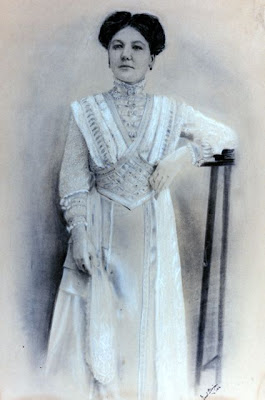
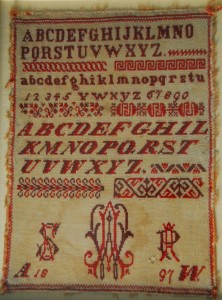
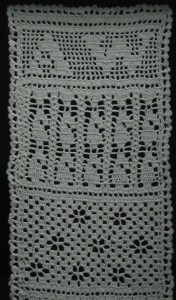

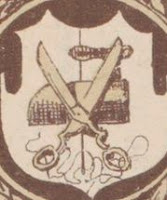
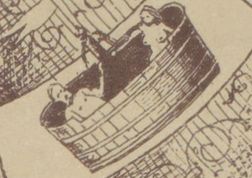
What a tribute to your great-grandmother! She is beautiful and clearly talented. I’m reminded every day of the diseases that took our ancestors prematurely that we now have to “google” to even understand what they are. I LOVE her dress.
I love her regal bearing – and that dress is absolutely amazing.
well she did find a man to love her for herself. She had amazing talent.
CLAP CLAP CLAP
Well done, great article and ooo, baby, that dress is wonderful!
Wonderful post–and the samplers are really exquisite. Your treasure trove opens onto more and more treasures!
What a beautiful story, she stands so proud and confident it’s hard to imagine she was scarred emotionally as well as physically. Keep up the great writing Linda.
Thank you Sharon & Lynn. So glad you are following my blog.
Exquisite! Her dress, her samplers, and her choice to become a master dress maker and designer. Certainly she married or you wouldn’t call her grandmother. I hope it was a happy marriage for her. Is the dress still in your family? It would be thrilling to hold it and look at the detail closely, wouldn’t it? A great post, Linda!
Superb post! I so love seeing the certificate and its detail with the examples of her skilled work. A real thrill to read and examine.
Today’s world is growing very rapidly. Everyone wants to look good.In this case cosplay outfit has a perfect balance between the lace and the open part. It gives you personal satisfaction. It has a wide variety of costumes. Cosplay Costume is one of top sellers this season.